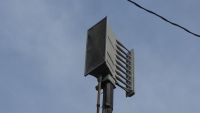WS-3000
| Whelen WS-3000 | |
 A Whelen WPS-3000 in Monroe County, MI. | |
| Company | Whelen Engineering |
|---|---|
| Produced | 1981-1991 |
| Type | Rotational Electronic |
| Sound output | 124 dB @ 100 feet |
| Wattage | 1280 W |
| Voltage | 24 V DC |
| Preceded by | Whelen WS-2000 |
| Succeeded by | Whelen WPS-4000 |
| Documentation | Manual |
The WS-3000 (later known as the WPS-3000) is a rotational electronic siren that was produced by Whelen Engineering over a span of 10 years, and was Whelen's first successful rotational siren. It was this siren that established Whelen's dominance in the electronic rotational siren market, and paved the way for their future sirens.
The WS-3000 would be discontinued in 1991, after the introduction of the WPS-4000 series, which not only outperformed it, but also used fewer, more powerful drivers to do so, which made them more reliable. Despite the siren having been discontinued for over 30 years, many WS and WPS-3000 units still operate in service, most of which are running on Whelen's newer digital controllers. A few still run on their original analog controllers, but these are rarer. Unfortunately, some are beginning to show their age, with failing drivers and rotator mechanisms, as well as dying batteries. Still, these sirens continue to serve many places and this is proof of how great the siren truly was.
Note: The WS-3000 is often mistakenly called the "WS-3016" or "WPS-3016" by various enthusiasts, however this name does not exist in Whelen's documentation. The official name for this siren is simply the WS-3000 or WPS-3000, depending on the controller used and the siren's age.
History and Design
The WS-3000 was created in 1981 by Whelen Engineering. Whelen had realized by this point that while they were enjoying great success with their omnidirectional WS-2000 series of sirens, they lacked a high performance siren that could match the rotating mechanical sirens that dominated the siren market. Whelen contacted Bruce Howze from Community Pro Loudspeakers, who had previously designed other sirens such as the WS-2500, to create a rotational electronic siren that could match the performance of Federal Signal's popular Thunderbolt siren. Whelen had already experimented with a rotational siren, the WS-2000R, but its performance was lacking. The WS-3000 solved its issues and had unrivaled performance for an electronic siren when it released.
The WS-3000 was the first of Whelen's sirens to use their "throat and horn" design. The siren makes use of 16 80 W high powered speaker drivers located inside a removable panel at the rear of the siren. Each driver connects to 16 staggered throats that converge into a single large projector, which is reinforced to prevent the horn from warping. The projector also includes a mesh screen to keep debris out of the siren. The siren was able to reach 124 dB at 100 feet, which was completely unrivaled for an electronic siren when it was released, and would be matched by Federal Signal's EOWS*812 that released later the same year. The siren is rotated using a small direct-drive reversible rotator with a high-torque DC motor, which oscillates 360 degrees at 2 oscillations per minute. This is because the siren does not use brushes, and instead the drivers are directly wired up to the controller. Oscillating prevents the wire from potentially snapping, and the direct wired connection improves the clarity and performance of the drivers. The rotator's design prevents the siren from acting as a weather vane in high winds as well, with the siren being designed to withstand winds of up to 145 miles per hour.
The rotator itself was made of aluminum, and was capable of quadrant control, meaning that the projector was capable of being remotely positioned in 8 different directions, with an internal optical sensor telling the controller which direction the projector is facing. Multiple WS-3000s could be synchronized from a central control system, which would prevent the distortion of voice messages due to clashing messages from different sirens. Every time the siren utilizes its voice functionality, it will automatically return to its "home" position before broadcasting voice messages in each direction, first in the immediate directions, and then the cardinal directions. The pre-ESC-864 and ESC-864 controllers the WS/WPS-3000 came stock with run the siren's drivers at 100W in voice mode, while running at 80W in siren mode.
In 1987, the siren would undergo a few design changes. An additional horizontal reinforcing bar was added to the projector, and the rotator was updated to switch from an optical sensor to a microswitch based sensor. Like the other "WS" sirens, the siren would gain the "WPS" prefix that year, ditching the "WS" prefix. A year later, in 1988, the rotator would be replaced entirely by the rotator used on the then-new WPS-4000 siren, standardizing the rotators to reduce costs. This rotator is taller and nearly cube-shaped.